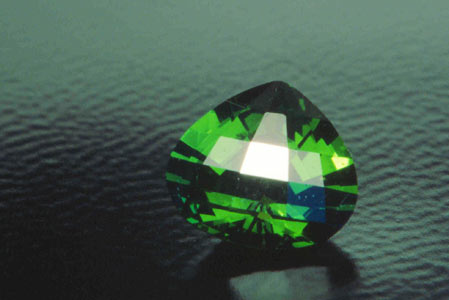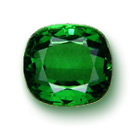 FREE SHIPPING on US orders over $150. Need help? Contact Us
FREE SHIPPING on US orders over $150. Need help? Contact Us Genuine Tsavorite Gemstone

Tsavorite
Brilliant green Tsavorite is rather a young gemstone with a truly ancient geological history. Its native country is the bushland along the frontier between Kenya and Tanzania. The sparse mines there are situated in a uniquely beautiful landscape of dry grassland with bare and dry hills. It is a dangerous region, where snakes feel at home and now and then a lion will hunt for prey. It is in this very region, not far away from the Tzavo National park, where our story begins.

The Once upon a time, in the year 1967, the British geologist Campbell R. Brides was prospecting for gemstones in the north-eastern part of Tanzania. Suddenly he came across some very odd, potato-shaped stone objects. And like in a fairy tale, he found breathtakingly beautiful green grains and crystal pieces inside these weird objects. Gemmological tests showed that he had discovered green grossularite, a mineral which had up to then been considered very rare, which belongs to the colourful Garnet family. The stones were very beautiful and of high transparency, so that his find made experts sit up ad take notice. Even Tiffany & Co. in New York expressed their interest in the newly discovered green jewel. But in spite of all efforts it ws impossible in those days to get an export licence for taking these stones out of Tanzania. Campbell Bridges, however, did not admit defeat. As geologist he knew that those layers in the soil which carry gemstones are generally not limited to just one spot, but usually stretch out over vast areas – and such a layer was what he had encountered according to his opinion. After all, the stone belt which accommodates most of East Africa’s gemstone mines is truly ancient. It was created many millions of years ago, when the continents where still moving around a lot. In those times the region in question ad been part of the bottom of the sea. The sedimental residue was compacted, folded and thus shaped by the movements of the earth plates. The extremely high pressure and high temperatures effected changes in the originally existing stones. Thus new and amazingly beautiful gemstones were created – among them also Tzavorite. But the gigantic forces of Nature involved in the process of creation had already damaged most of the crystals so that we usually only find grains and pieces of them today.
Campbell R. Bridges stubbornly continued his search. His theory that the gemstone loaded vein might even extend into the Kenyan territory finally set him on the right track. In the year 1971 he discovered the brilliantly green gemstone for a second time, this time in Kenya, where he could officially register his find and could start exploiting the occurrence. This was the beginning of a new adventure: in order to protect himself from wild animals Bridges lived in a tree house at first. And as he di not want his treasure to be stolen, he cunningly employed the workers’ fear of snakes and had the rough stones guarded by a python snake. It was a beautiful find indeed. Unfortunately, however, the stone was only known to experts. This changed quickly when in 1974 Tiffany’s started a special promotion campaign making Tzavorite well-known in all the USA in only a short time. Other promotion campaigns in other countries followed, and soon Tzavorite was a name known everywhere.
Green like Garnet ...
Why is it called Tzavorite or Tzavolith respectively if it is after all a green Grossularite from the colourful Garnet family? Naming gemstones is performed according to certain rules. Modern mineralogical nomenclature demands that gemstones are given a name ending in "ite". To honour the Tzavo National Game Park and the Tzavo river running through this area, Henry Platt , the former president of Tifany & Co, who accompanied the gemstones rise to popularity, had suggested the name Tzavorite. Sometimes, however, Tzavolith is used but both denote the same stone. The ending "lith” is simply the Greek word for "stone”.
What makes Tzavorite so desirable? First of all there is its vividly brilliant green. The colour scale shown by Tzavorite ranges from spring-like pale green via intensely bluish green to deep forest green. – colours which have an invigorating and fresh effect on the senses. The gemstone is also coveted because of its high brilliance. Like all other Garnets it enjoys an especially high light refraction index (1.734/ 44). Not without reason, then, did old legends claim that garnets where difficult to hide. Their sparkling light was reported to be visible even trough clothes.
Contrary to other gemstones, Tzavorites are not heated or oiled. This is not necessary for this gemstone. Like all other Garnets it is a piece of immaculate and pure nature. Another positive characteristic is its robustness. Although showing a hardness similar to Emerald - circa 7 1/2 on the Mohs´Scale – it is far less sensitive in its handling. This is not only important for cutting and setting the stone, but also for wearing. Tzavorite is less likely to become damaged or to splinter even as consequence of abrupt or incautious impact. It is excellently suited for the favoured style of "invisible setting", where stones are set closely joined, and which cannot be recommended for Emeralds. Due to its high brilliance, Tzavorite here is an equal match for the classical stones like Diamond, Ruby an Sapphire.
Only occasionally a rough crystal of over 5 carats is found, so that cut Tzavorites are quite rare and valuable starting from sizes of 2 carats on. But the brilliance and luminosity of the stone are displayed even in smaller sizes.
It is really something special, this young gemstone with the ancient history. Its bright and vivid green, excellent wearing and high brilliance at relatively inexpensive prices make it without doubt one of the most convincing and honest gemstones.



